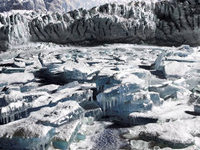Previously unknown bacteria unearthed after 3,000 years
American biologists discovered live cells in the water of Antarctic Lake Vida. According to estimates, microorganisms have been staying underneath the ice layer for nearly 3,000 years.

According to Rossiyskaya Gazeta, the found cells are capable of living in extreme conditions: in absolute darkness, in very salty water, in complete isolation and at very low temperatures. The average temperature at which bacteria can survive -makes up -14 degrees Celsius.
The scientists were able to make the discovery as a result of several polar expeditions. Popular Mechanics magazine reports that the biologists drilled wells in the lake twice - in 2005 and 2010 - to reach the ice layer. The biologists discovered first signs of life in the icy lake in 2002.
It goes about 32 established bacteria species. According to scientists, their survivability can be explained with tough natural conditions under which they exist. Extreme conditions slowed down all chemical processes in the cells, while metabolism reduced to the lowest level.
According to Planet news agency, another group of scientists currently explores Antarctic Lake Vostok. The lake is covered with a three-kilometer ice cap. Scientists have finished drilling the well in the lake. If biologists manage to obtain the necessary samples, it will give an opportunity to explore a more ancient material.
Lake Vostok has been isolated from the world for much a longer time than Lake Vida. If scientists find any bacteria in the water of the lake, they are likely to be very different from those that were found in the water of Lake Vida.
Subscribe to Pravda.Ru Telegram channel, Facebook, RSS!


